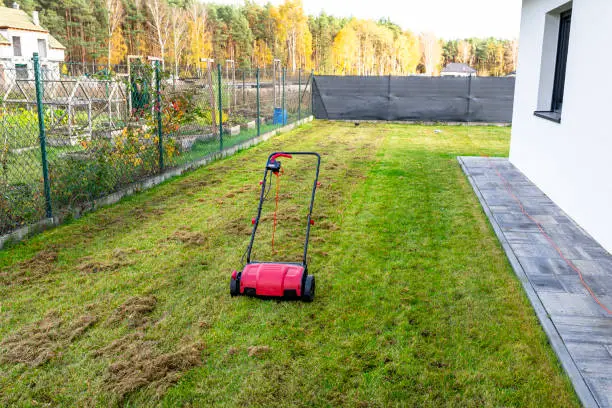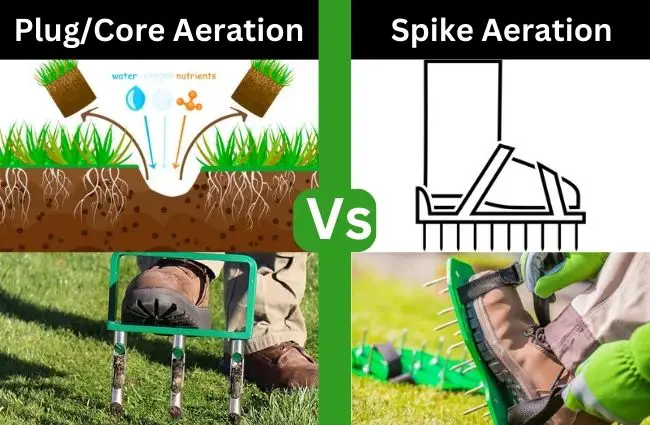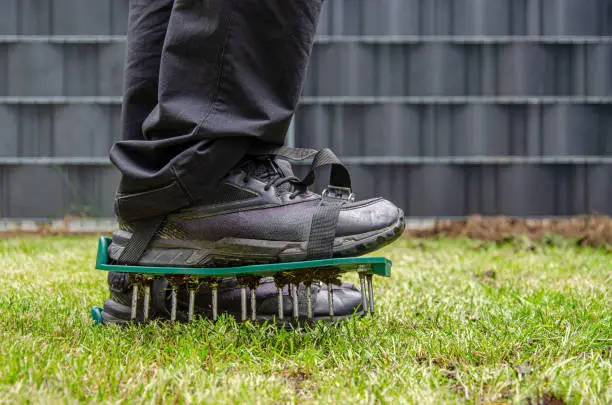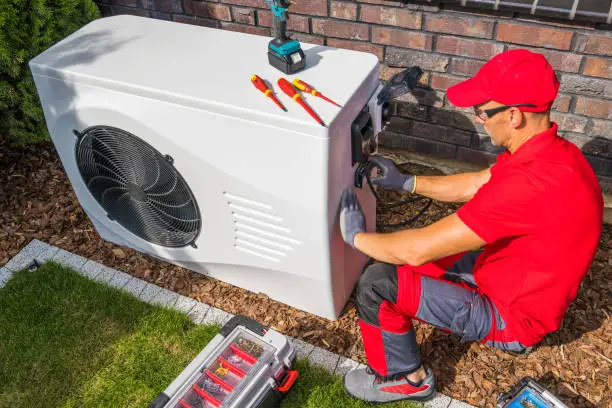Helpful Guides on each Category

Want a greener, thicker lawn with less work? Knowing the best time to aerate lawn makes a big positive impact. One of the best things you can do for your grass is aeration – but only if you do it at the best time.
In summary, for cool-season grasses like Kentucky bluegrass and fescue, the best time to aerate your lawn is in early fall (September–October) or early spring (March–April); for warm-season grasses like Bermuda or Zoysia the best time is late spring to early summer (May–June) when the grass is actively growing.
So lets teach you the best time to aerate lawn based on your grass type and where you live. You’ll learn why timing matters, how to know if your lawn needs aeration, and what steps to take before and after the process.
Read Also: 5 Best Lawn Aerator to Improve Grass and Soil.
What is Lawn Aeration?

Lawn aeration is the process of making small holes in your lawn to let air, water, and nutrients move more freely into the soil and reach the roots of your grass. Over time, soil can become compacted, especially in high-traffic areas, making it hard for your lawn to breathe and grow.
Aerating your lawn helps it breathe. It breaks up compacted soil so that water, nutrients, and oxygen can reach the roots more easily. This leads to stronger, healthier grass that can better handle heat, drought, and foot traffic.
How Lawn Aeration Works
When you aerate your lawn, you’re helping loosen up the soil. This allows the roots to grow deeper and stronger, which leads to a healthier, greener lawn. The holes created during aeration also make it easier for fertilizer and water to do their job more effectively.
Types of Lawn Aeration

There are two common methods:
- Core (Plug) Aeration: This method removes small plugs of soil from the lawn. It’s the most effective way to relieve compaction and is recommended for most lawns.
- Spike Aeration: This method uses solid spikes to poke holes into the ground. It’s easier to do but less effective for heavily compacted soil, since it can push soil sideways rather than removing it.
Not all lawns are the same. Using spike aerators on highly compacted clay soil won’t do much good—in fact, it can make things worse. For most home lawns, core or plug aerators are the best choice, especially for serious compaction.
Why You Should Know the Best Time to Aerate Your Lawn
When you aerate at the wrong time of year, your grass may struggle to recover. Instead of growing stronger, it could become stressed, thin out, or be taken over by weeds. That’s why timing mattters for lawn aeration based on your specific lawn.
Key Factors That Affect Timing
- Soil Temperature: Grass needs to be actively growing to heal and fill in the holes left behind during aeration. Cold or overly dry soil slows this process down.
- Grass Type: Not all lawns grow the same way. Some grow best in cooler months, while others thrive in the heat. Knowing your grass type helps you choose the right time to aerate.
- Seasonal Growth Patterns: Aeration should always be done during or just before your lawn’s peak growing season. This helps it recover quickly and grow even thicker.
Cool-Season vs. Warm-Season Grasses
- Cool-Season Grasses (like Kentucky Bluegrass, Fescue, and Ryegrass) grow best in spring and fall. For these lawns, fall is usually the best time to aerate.
- Warm-Season Grasses (like Bermuda, Zoysia, and St. Augustine) grow best in late spring and summer. These lawns should be aerated in late spring when the grass is actively growing.
Download our Printable Calendar Guide (PDF)
US REGIONS INCLUDED
Best Time to Aerate Lawn for Cool-Season Grasses

Cool-season grasses, like Kentucky Bluegrass, Fescue, and Ryegrass, are best for cooler climates. These grasses grow most actively during the fall and early spring, making these the ideal times for aeration.
Best Time to Aerate Cool-Season Grasses: Early Fall or Early Spring
- Early Fall (Sept–Oct): Fall is generally the best time to aerate cool-season lawns. The temperatures are cooler, and rainfall is more consistent, creating the perfect conditions for grass to recover and thrive after aeration.
- Early Spring (Mar–Apr): If you miss the fall window, early spring is the second best option. Just make sure the ground is thawed and your grass is starting to green up. This timing allows your lawn to recover quickly as it enters its peak growing season.
Why Fall is the Best Time for Aeration
- Recovery Time: After aeration, your lawn needs time to heal and fill in the holes. Fall gives your grass a few months to recover before the stress of winter arrives.
- Less Weed Pressure: In the fall, weeds are less of an issue, allowing your grass to fill in the holes without competition.
- Ideal Moisture: Fall generally brings cooler weather and more rain, which is perfect for helping your lawn recover and grow after aeration.
Tips for Cool-Season Lawn Prep Before and After Aeration
Before Aeration:
- Mow your lawn to about 2–3 inches to ensure the aeration equipment can reach the soil easily.
- Water your lawn well a day or two before aerating. This softens the soil and makes the process more effective.
After Aeration:
- Overseed your lawn to encourage new growth in the holes created by the aeration process. This helps fill in thin or bare spots.
- Apply a balanced fertilizer to boost grass growth.
- Keep the lawn well-watered (but not soggy) to support the new grass and help it recover.
- Avoid heavy foot traffic on your lawn for a few weeks to let the grass regenerate.
READ ALSO: The 7 Best Lawn Levelling Rakes (Gardening and Landscaping).
Best Time to Aerate Warm-Season Grasses
Warm-season grasses, such as Bermuda, Zoysia, St. Augustine, and Centipede, thrive in hotter climates and grow best during the warmer months when the temperatures are consistently above 60°F (15°C). For these grasses, timing aeration correctly is essential to help them recover and grow strong.
The best Time to Aerate lawn with Warm-Season Grasses is Late Spring to Early Summer from May to June when the soil has warmed up and the grass is actively growing.
Aerating during this time ensures that your grass can heal quickly and continue growing strong throughout the summer. Avoid Aerating During the Heat of Summer, although warm-season grasses thrive in the summer, aerating during peak summer heat (July and August) will stress the grass and delay recovery.
Climate-Specific Advice for Southern States
In the Southern U.S., where warm-season grasses are most common, the summer months are very hot. Aerating too late in the season can stress your grass, so it’s important to do it earlier in late spring.
- Bermuda and Zoysia lawns should be aerated early in the growing season to ensure they have enough time to recover before the hottest part of the summer.
- St. Augustine and Centipede also benefit from aeration in late spring when the soil is warm, but they may require slightly more water to help them recover.

Agri-Fab Tow Behind Lawn Plug Aerator
- 32 galvanized knives
- Pulls plugs up to 3 inches deep
- Flat free tires for smooth transport.
- 3 Year Limited Consumer Warranty
- Simple-to-use cantilever transport handle
Regional Considerations on the Best Time to Aerate Your Lawn
While grass type plays a big role in lawn care, where you live can also affect the best time to aerate lawn. Climate, soil type, and local weather patterns all impact how and when you should aerate. Here’s a quick look at what to consider based on your region:
Northeast
In the Northeast, cool-season grasses like Fescue and Kentucky Bluegrass are common. The best time to aerate lawn here is early fall (September to early October), when temperatures cool down and rain is more frequent. Early spring is also an option, but fall is better for long-term lawn health and recovery.
Midwest
The Midwest often has compact, clay-heavy soils that benefit greatly from core aeration. Like the Northeast, fall is typically the ideal time to aerate cool-season lawns. Be sure to aerate after a rain or watering—clay soil is tough to penetrate when dry.
South
In Southern states, warm-season grasses are the norm. Aerate in late spring to early summer (May to June), when the grass is actively growing. Avoid aerating in mid-summer when heat and drought stress are highest, as this can damage your lawn instead of helping it.
West
Western regions often deal with dry, arid climates. If you live in the West, time your aeration around your irrigation schedule. Water your lawn well the day before aerating, and aim for late spring to early summer if you have warm-season grass. For higher elevations or cooler parts of the West, early fall may be better if you grow cool-season grass.
RELATED POST: Lawn worm: Identify and get Rid of Lawn worms.
How to Tell If Your Lawn Needs Aeration
Not sure if your lawn actually needs aeration? Here are some easy signs to watch for. If you notice one or more of these, it’s time to pull out the aerator—or call in a pro.
- Water Pooling: After watering or rain, do you see puddles that stick around? Poor drainage is a common sign of compacted soil.
- Thatch Buildup: A thick layer of dead grass and roots (called thatch) can block water and nutrients. If thatch is over half an inch thick, it’s time to aerate.
- Hard, Compacted Soil: If the ground feels rock-hard and is tough to dig into, it’s likely compacted and needs to be loosened.
- Poor Grass Growth: Thin, patchy grass—even with regular watering and feeding—can mean roots aren’t getting what they need due to compacted soil.
Quick DIY Test: The Screwdriver or Foot Test
- Screwdriver Test: Try pushing a screwdriver into the soil. If it’s hard to insert, your soil is likely too compacted.
- Foot Test: Walk across your lawn. If it feels hard and bouncy rather than soft and springy, that’s another sign aeration might help.
Some lawns naturally compact faster than others. You may need aeration more often if:
- Your yard gets heavy foot traffic (kids, pets, gatherings).
- You recently built or remodeled (construction compacts soil).
- You regularly use riding mowers or heavy equipment on the grass.
DIY vs Professional Aeration
When it comes to aerating your lawn, you have two main options: do it yourself or hire a professional. Both have their benefits—depending on your lawn size, budget, and comfort level.
Cost Breakdown
- DIY (Renting Equipment): $40–$90 daily for a core aerator rental from a local hardware or garden store.
- Professional Aeration: $75–$250+, depending on the size of your lawn and location.
Pros of Renting a Machine
- Cost-effective for small to medium lawns
- You control when and how it’s done
- Great if you’re comfortable with lawn equipment
Cons of Renting a Machine
- Machines are heavy and bulky to handle
- Less precise if you’re inexperienced
- You still have to prep and clean up
When to Call a Pro
Consider hiring a professional if:
- You have a large yard or difficult terrain
- Your soil is heavy clay and hard to penetrate
- You’re not familiar with how to operate a core aerator
- You want to bundle aeration with overseeding or fertilizing
Post-Aeration Lawn Care Tips
After Aeration, these are what you should do;
- Overseed (Optional): If your lawn has bare spots or thinning areas, now is the perfect time to overseed. The holes left by aeration create ideal seed-to-soil contact.
- Fertilize: Apply a balanced fertilizer to give your grass the nutrients it needs to grow strong and green. Choose one that matches the season and your grass type.
- Water Properly: Keep your lawn evenly moist for a few weeks after aeration. Water deeply but not too often, this encourages deep root growth.
- Hold off on mowing for a few days after aeration (especially if you overseed).
- Once grass starts growing again, return to a regular mowing schedule, but don’t cut it too short.
- Avoid Heavy Traffic: Try to limit walking, playing, or mowing on your lawn for at least 7–10 days. This gives your lawn time to recover and lets new roots settle in.
Best Time to Aerate Lawn: Quick Reference Graphic Aeration Timing Cheat Sheet
Here’s a simple guide to help you quickly find the best time to aerate lawn based on your grass type:
| Grass Type | Season Type | Best Time to Aerate |
| Kentucky Bluegrass | Cool-season | September–October |
| Tall Fescue | Cool-season | September–October or March–April |
| Fine Fescue | Cool-season | September–October |
| Creeping Bentgrass | Cool-season | September–October |
| Annual Ryegrass | Cool-season | September–October |
| Bermuda Grass | Warm-season | May–June |
| Zoysia Grass | Warm-season | May–June |
| Centipede Grass | Warm-season | May |
| Bahia Grass | Warm-season | May–June |
| Buffalo Grass | Warm-season | May |





